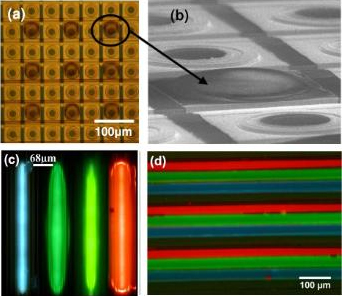Hybrid inorganic/organic devices
Each pixel within a micro-LED arrays made from standard multi-quantum well (MQW) wafer will emit the same colour of light. For many applications it would be desirable to have an array of pixels emitting various different colours, for example, for colour micro-displays or for spectroscopy. One way to achieve this is to integrate “colour-converters”, such as colloidal quantum dots or light-emitting conjugated polymers, onto the pixels. These materials absorb the emission from the micro-LEDs and re-emit light of a different colour.
We have shown that these materials can be selectively patterned to achieve a multi-colour array by various techniques. These include:
- ink-jet printing [1]
- laser direct writing where a laser beam is scanned across a substrate to selectively polymerise a layer of material
- self-aligned writing [2] which uses a UV-emitting µLED to polymerise and subsequently optically excite colour-converting material
The figure below shows micrograph images of the results of ink-jet printed (a,b), laser-direct writing (c) and self-aligned writing (d) processes.

These materials also have applications for communications. A periodically-patterned green-emitting conjugated polymer layer has been integrated with a blue-emitting micro-LED [3], where polymer layer serves to efficiently convert the emission from the LED to the green region of the spectrum where the absorption losses of polymer optical fiber (POF) is lowest.
Furthermore, the patterning of the polymer layer strongly modifies the converted light such that it is highly directional and has a narrower spectral emission, properties which can enhance coupling of light into POF. Finally, due to the short lifetime (~0.6 ns), of the polymer the conversion of blue to green emission is achieved without significantly reducing the modulation bandwidth of the device.
References
[1] M. Wu et al., “Star-shaped oligofluorene nanostructured blend materials: controlled micro-patterning and physical characteristics,” Applied Physics A: Materials Science & Processing, vol. 97, no. 1, pp. 119–123, (2009).[2] B. Guilhabert et al.,“Integration by self-aligned writing of nanocrystal/epoxy composites on InGaN micro-pixelated light-emitting diodes,” Optics Express, vol. 16, no. 23, pp. 18933–18941, (2008).
[3] J. Herrnsdorf et al., “Hybrid organic/GaN photonic crystal light-emitting diode,” Applied Physics Letters, vol. 101, no. 14, p. 141122, (2012).